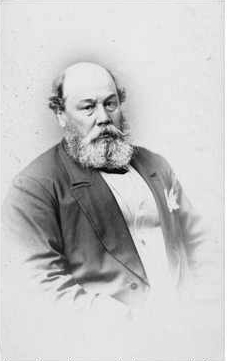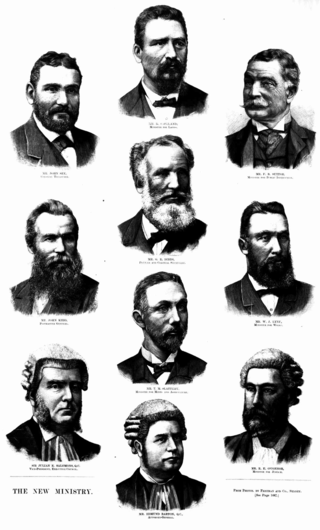Related Research Articles

Sir Henry Parkes, was a colonial Australian politician and longest non-consecutive Premier of the Colony of New South Wales, the present-day state of New South Wales in the Commonwealth of Australia. He has been referred to as the "Father of Federation" due to his early promotion for the federation of the six colonies of Australia, as an early critic of British convict transportation and as a proponent for the expansion of the Australian continental rail network.

Henry Daglish was an Australian politician who was the sixth premier of Western Australia and the first from the Labor Party, serving from 10 August 1904 to 25 August 1905. Daglish was born in Ballarat, Victoria, and studied at the University of Melbourne. In 1882, he worked as a mechanical engineer but soon switched to working in the Victorian public service. He first stood for election in 1896 but failed to win the Victorian Legislative Assembly seat of Melbourne South. He then moved to Subiaco, Western Australia, where he found work as a chief clerk in the Western Australian Police Department. In 1900, Daglish was elected to the Subiaco Municipal Council and in April the following year, he was elected to the Western Australian Legislative Assembly as the member for the newly created seat of Subiaco, becoming one of six Labor members in the Western Australian Legislative Assembly. The party elected him as its whip, and he resigned from the Subiaco council on 1 May 1901. On 1 December 1902, Daglish was sworn in as mayor of Subiaco, having been elected the previous month.

Saufatu Sopoanga was a Tuvaluan politician who served as the eighth prime minister of Tuvalu from 2 August 2002 to 27 August 2004. He drew international attention for his speeches warning about the effects of the rising sea level on Tuvalu and other low-lying island countries.

John Joseph Cahill, also known as Joe Cahill or J. J. Cahill, was a long-serving New South Wales politician, railway worker, trade unionist and Labor Party Premier of New South Wales from 1952 to his death in 1959. Born the son of Irish migrants in Redfern, New South Wales, Cahill worked for the New South Wales Government Railways from the age of 16 before joining the Australian Labor Party. Being a prominent unionist organiser, including being dismissed for his role in the 1917 general strike, Cahill was eventually elected to the Parliament of New South Wales for St George in 1925.

The New South Wales Legislative Assembly is the lower of the two houses of the Parliament of New South Wales, an Australian state. The upper house is the New South Wales Legislative Council. Both the Assembly and Council sit at Parliament House in the state capital, Sydney. The Assembly is presided over by the Speaker of the Legislative Assembly.

Sir Frederick William Holder was an Australian politician who served as the first speaker of the Australian House of Representatives from 1901 to 1909. A member of the Free Trade Party and later an independent, he served twice as the 19th premier of South Australia from June to October 1892 and again from 1899 to 1901. He was a prominent member of federation movement and the first Parliament of Australia, following Federation in 1901.

Sir James Martin, QC was three times Premier of New South Wales, and Chief Justice of New South Wales from 1873 to 1886.

Sir Arthur Blyth was Premier of South Australia three times; 1864–65, 1871–72 and 1873–75.

Sir George Stephenson Beeby KBE was an Australian politician, judge and author. He was one of the founders of the Labor Party in New South Wales, and represented the party in state parliament from 1907 to 1912. He fell out with the party and later served as an independent, a Nationalist, and a Progressive. He left parliament in 1920 to join the state arbitration court, and in 1926 was appointed to the Commonwealth Court of Conciliation and Arbitration. He was Chief Judge from 1939 until his retirement in 1941.
In the United Kingdom, confidence motions are a means of testing the support of the government (executive) in a legislative body, and for the legislature to remove the government from office. A confidence motion may take the form of either a vote of confidence, usually put forward by the government, or a vote of no confidence, usually proposed by the opposition. When such a motion is put to a vote in the legislature, if a vote of confidence is defeated, or a vote of no confidence is passed, then the incumbent government must resign, or call a general election.

The third Dibbs ministry, the 27th ministry of the Colony of New South Wales, was led by Sir George Dibbs, leader of the Protectionist Party, following the 1891 New South Wales election, which saw the Labour Party win seats in the New South Wales Legislative Assembly and the balance of power. With no party having a majority, Sir Henry Parkes held on as Premier until October 1891 when he lost a vote in the Legislative Assembly, causing Parkes to resign as Premier and leader of the Free Trade Party. Dibbs formed the ministry on 23 October 1891, with Labour support, and comprised 10 ministers.

The Leader of the Government in the Senate is the government's most senior cabinet minister in the Australian Senate and the main government spokesperson in the Senate. His or her Opposition counterpart is the Leader of the Opposition in the Senate.

Elections were held in the Australian state of Queensland on 27 August 1904 to elect the members of the state's Legislative Assembly. The Ministerial Party maintained government with the continued support of the Labour Party.
The Finniss ministry was the 1st Ministry of the Government of South Australia, led by B. T. Finniss. It commenced on 24 October 1856 with the introduction of responsible government in South Australia, and the nomination by Governor Richard Graves MacDonnell of Finniss, the appointed Chief Secretary, as the first Premier of South Australia. The ministry operated for several months prior to the 1857 colonial election, which would elect the first House of Assembly. The first House of Assembly was elected in March 1857 and met in April. The Finniss ministry was succeeded by the Baker ministry on 21 August 1857, following their defeat on a confidence motion in the new House.
The Baker ministry was the 2nd Ministry of the Government of South Australia, led by Premier John Baker. It commenced on 21 August 1857 after Baker's allies defeated the Finniss ministry in the House of Assembly. The ministry lost a confidence vote after only two days, announced that they would resign, and adjourned parliament until the formation of the Torrens ministry on 1 September 1857. At 11 days in office, it is the third-shortest ministry in South Australian history.
The First Reynolds Ministry was the 5th Ministry of the Government of South Australia, led by Thomas Reynolds. It commenced on 9 May 1860, following Reynolds' defeat of the Hanson Ministry on a confidence vote in the House of Assembly. The ministry was defeated in May 1861, but Reynolds' opponents were unable to form government, and he formed the reconstituted Second Reynolds Ministry on 20 May 1861.
The First Dutton Ministry was the 9th Ministry of the Government of South Australia, led by Francis Dutton. It commenced on 4 July 1863, when Dutton, who had moved the motion to oust his predecessor, was sworn in to lead what was reported to be an interim ministry to deal with the Tariff Bill. However, the ministry was defeated on a series of adjournment votes on its first sitting day in parliament, and announced their resignation for lack of the parliament's confidence. Randolph Isham Stow was sent for but failed to win support to succeed Dutton, and with former Premier George Waterhouse and Arthur Blyth both lacking support, Henry Ayers was finally sent for and sworn in heading the First Ayers Ministry on 15 July.
The Second Ayers Ministry was the 11th Ministry of the Government of South Australia, led by Henry Ayers. It commenced on 22 July 1864, when Ayers succeeded in reconstituting his ministry following its defeat on a no-confidence motion. It collapsed within days when both the new ministers, William Milne and Randolph Isham Stow, resigned, necessitating the resignation of the entire ministry. It was succeeded on 4 August 1864 by the First Blyth Ministry.
The First Blyth Ministry was the 12th Ministry of the Government of South Australia, led by Arthur Blyth. It commenced on 4 August 1864, when Blyth succeeded in forming a ministry following the resignation of the Second Ayers Ministry. It was succeeded by the Second Dutton Ministry on 22 March 1865, when Francis Dutton won the support of the new parliament that had been elected at the 1865 election.
References
- ↑ "Statistical Record of the Legislature, 1836-2009" (PDF). Parliament of South Australia. Archived from the original (PDF) on 11 March 2019. Retrieved 19 September 2015.
- ↑ "POLITICAL CRISIS IN SOUTH AUSTRALIA". The Age . Melbourne. 18 June 1892. p. 9. Retrieved 20 September 2015– via National Library of Australia.
- ↑ "PARLIAMENTARY". South Australian Register . Adelaide. 18 October 1892. p. 3. Retrieved 20 September 2015– via National Library of Australia.